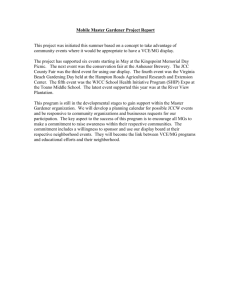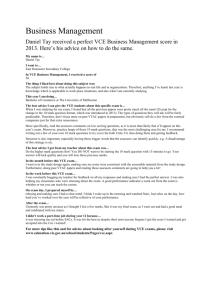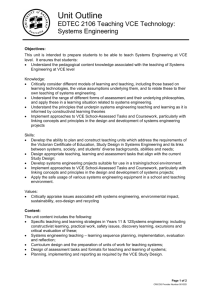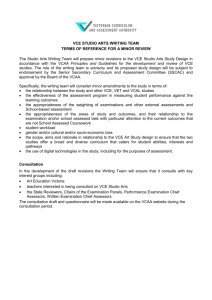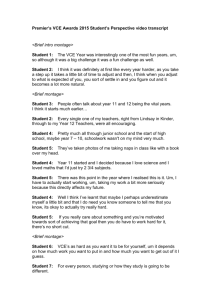Chapter 9 - Assessment of Fitness
advertisement
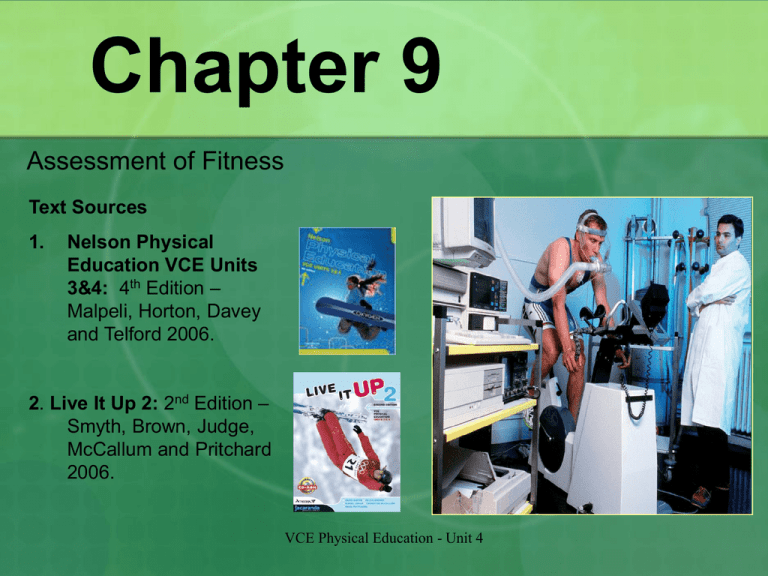
Chapter 9 Assessment of Fitness Text Sources 1. Nelson Physical Education VCE Units 3&4: 4th Edition – Malpeli, Horton, Davey and Telford 2006. 2. Live It Up 2: 2nd Edition – Smyth, Brown, Judge, McCallum and Pritchard 2006. VCE Physical Education - Unit 4 Assessing Fitness Assessment of Fitness Reasons for Fitness Testing Identify the athlete’s capability to perform certain tasks Identify athlete’s strengths and weaknesses, which can be used to develop/evaluate a training program Tests should be re-tested every 8-12 weeks to give coach-athlete feedback (one-off testing is pointless) Testing can motivate athlete’s to strive for improvement in their fitness. Performance Evaluation Laboratory Tests; Assessment from expensive and sophisticated equipment in laboratories. Performed usually only at elite level (Sports institutes), but are very accurate (Eg. Maximal tests) Field Tests; Commonly carried out, as they are simple and results are instantaneous. Commonly carried out in individual and team sports to gauge ones fitness levels and can are specific to the fitness components required in particular sports. Maximal and Sub-maximal Testing See table 9.1 p.195 VCE Physical Education - Unit 4 Direct and Indirect Testing There are two broad approaches to testing – direct, maximal testing and indirect sub-maximal testing. Each has its advantages and disadvantages Direct – lab equipment, HR monitor, etc Indirect predictive measures/ equations Direct testing tends to be confined to laboratories Indirect sub-maximal testing tends to be used most often because it is easy to administer, requires less expertise and requires minimal effort. VCE Physical Education - Unit 4 The Evaluation Process 1. 2. 3. 4. 5. 6. Select the fitness components to be tested (Via game analysis) Select a suitable fitness test* Collect the data scientifically Analyse the data to determine strengths and weaknesses Make decisions as to what to do with the test results Design a training program to work on an athletes weaknesses and maintain their strengths VCE Physical Education - Unit 4 Checkpoints Complete questions 1-5 page 195 of Nelson Physical Education VCE Units 3 & 4. VCE Physical Education - Unit 4 Test Selection Criteria Each fitness test should be: Relevant: Selected fitness should assess the performance capabilities of the relevant major muscle groups, and also the patterns and speeds of movement performed. Specific: The predominant energy systems and fitness components utilised in an activity should form the basis for the selection of tests. Valid: An appropriate fitness test must be valid in that it should measure what it claims to measure. For example, if a test claims to measure aerobic capacity it should be of sufficient duration to test the capacity of this energy system. Reliable: Fitness tests must be able to be repeated with consistently accurate results. Reliability is dependent upon a number of factors remaining constant. — The same warm-up should be performed. — The same sequence of tests should be conducted. — The same recovery period between tests should be provided. — The athlete should be tested at approximately the same time of day. — The athlete should be in a similar fluid and nutritional state. — The environmental conditionsVCE of heat, Physicalhumidity Education -and Unit air 4 movement should be similar. Pre-testing procedures The following is a checklist of recommended procedures and precautions that should be followed before undertaking any form of fitness testing. • The individual should be fully informed and familiarised with the procedures and format of the test(s). • No food should be consumed immediately before the testing session. (approx 2hrs) • Appropriate clothing and footwear should be worn. • Heavy or intense exercise should be avoided on the day prior to testing. • The individual should give their consent and appropriate medical clearances should have been obtained. • Untrained individuals should work at maximum intensities for short periods only, and their responses should be closely monitored. This is to ensure that they do not injure themselves or run the risk of overtaxing themselves. VCE Physical Education - Unit 4 Standards and Norms Where available, an athlete may make use of ‘norms’ (standards that are ‘normal’ or typical for a group) but caution should be exercised in referring to these norms. Where norms are not available, the athlete should use personal bests (PB’s) as a guide. VCE Physical Education - Unit 4 Checkpoints Complete questions 1-3 page 197 of Nelson Physical Education VCE Units 3 & 4. VCE Physical Education - Unit 4 Fitness Tests Assessment of Fitness Aerobic Capacity Aerobic Capacity Copper’s 12 minute run Harvard Step Test Critical swim speed test 20m shuttle run test 1.6km jog test (1 mile) VCE Physical Education - Unit 4 Anaerobic Capacity The two measures of anaerobic capacity include measurement of the capacity of the ATP–PC system and measurement of the capacity of the anaerobic glycolysis (lactic acid) system. Tests to assess the capacity of the ATP–PC system need to include activities of short duration (0–10 seconds) and maximum intensity (100 per cent effort). Tests to measure the capacity of the anaerobic glycolysis system need to be performed at maximal or near-maxima intensity (95−100 per cent) and be sustained for a period of time between 30−90 seconds. VCE Physical Education - Unit 4 Anaerobic Power/Speed Phosphate recovery test Anaerobic sprint test (RAST) Repco peak power test Sprint standing starts 50m sprint test VCE Physical Education - Unit 4 Coursework 9.1 and 9.2 Complete the data analysis task on page 205 and 208 of Nelson Physical Education VCE Units 3 & 4. VCE Physical Education - Unit 4 Muscular Endurance, Strength and Power Muscular Endurance Sit ups Push ups Modified/pull ups Muscular strength Grip strength Core muscle strength Muscular Power Standing Long Jump Vertical Jump VCE Physical Education - Unit 4 Coursework 9.3 Complete the data analysis task on page 217 of Nelson Physical Education VCE Units 3 & 4. VCE Physical Education - Unit 4 Flexibility Flexibility Sit and reach Shoulder & wrist elevation Trunk and neck extension Shoulder rotation Ankle extension / flexion Shoulder rotation VCE Physical Education - Unit 4 Agility Agility Illinois agility test Semo agility test VCE Physical Education - Unit 4 Body Composition BMI Skinfold test underwater weighing (hydrodensitometry), waist-to-hip ratio. VCE Physical Education - Unit 4 Fitness Profiles and Batteries Assessment of Fitness Fitness Profiles and Batteries Grouping of fitness tests targeted at particular groups eg. Schools. Battery tests provide a fitness profile for athletes Examples; ACHPER Australian Fitness Education Award, Sport Search Fitness Program Advantages; Reliable and valid, norm/criterion referenced standards (With percentiles and ratings), a final score is achieved. Disadvantages; Not sport specific. VCE Physical Education - Unit 4 Checkpoints Complete questions 3 page 221 of Nelson Physical Education VCE Units 3 & 4. VCE Physical Education - Unit 4 Peak Performance Complete the chapter questions on page 6370 of Nelson Peak Performance Physical Education VCE Units 3 & 4. VCE Physical Education - Unit 4 Test Your Knowledge Complete the review questions 1-5 page 191 of Nelson Physical Education VCE Units 3 & 4. VCE Physical Education - Unit 4 PHYS ED Notes Read the summarised information of pages 98-115 of PHYS ED Notes and complete the revision questions. VCE Physical Education - Unit 4 VCAA Questions - 2006 VCE Physical Education - Unit 4 Web Links – Chapter 9 •Peak Centre for human performance (Canada): http://www.peakcentre.ca/faq.htm •Sport Specific (encyclopedia of sports performance enhancement): http://www.sportspecific.com/ •Sports Coach UK – evaluation: http://www.brianmac.demon.co.uk/eval.htm •Sports Coach UK – conditioning: http://www.brianmac.demon.co.uk/conditon.htm •ExRx Fitness Testing: http://www.exrx.net/Testing.html •Go For Your Life: http://www.goforyourlife.vic.gov.au •RobWood’s guide to fitness testing: http://www.topendsports.com/testing/ •Australian Sports Commission: http://www.ausport.gov.au •Find 30 promotion (Government of WA Department of Health): http://www.find30.com.au •Walking School Bus promotion (UK): http://www.walkingbus.com •Ministry of Health (New Zealand) toolkits: http://www.newhealth.govt.nz •The 10,000 Steps Rockhampton project: http://www.10000steps.org.au/rockhampton/ •Travelsmart Australia: http://www.travelsmart.gov.au •World Health Organisation: http://www.who.int •Heart Foundation Australia: http://www.heartfoundation.com.au •VicHealth (The Victorian Health Promotion Foundation): http://www.vichealth.vic.gov.au •Be Active promotion (Government of South Australia): http://www.beactive.com.au •Go For Your Life: http://www.goforyourlife.vic.gov.au •Physical Activity Resources for Health Professionals – Introduction (Centre for disease control and prevention – USA): http://www.cdc.gov/nccdphp/dnpa/physical/health_professionals/index.htm •Health Promotion (Public Health Agency of Canada): http://www.phac-aspc.gc.ca/hp-ps/index.html •Strategic Inter-Governmental Forum on Physical Activity and Health (SIGPAH): http://www.nphp.gov.au/workprog/sigpah/ •Healthy youth (Centre for disease control and prevention (USA): http://www.cdc.gov/HealthyYouth/ •America On The Move promotion: http://www.americaonthemove.org •Papers from the International Journal of Behavioural Nutrition and Physical Activity: http://www.ijbnpa.org/home •Department of health and aging (Australian government): http://www.health.gov.au/internet/wcms/publishing.nsf/content/home •Building a healthy, active Australia (Australian government): http://www.healthyactive.gov.au •National Public Health Partnership: http://www.nphp.gov.au •Be Active promotion (Government of South Australia): http://www.beactive.com.au •Sport and Recreation Australia: http://www.sport.vic.gov.au VCE Physical Education - Unit 4
